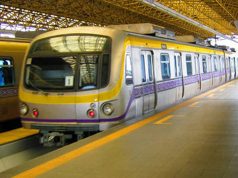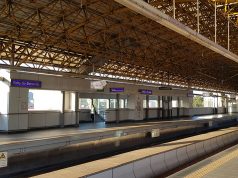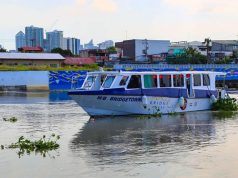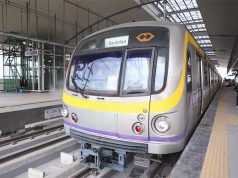As the government is set to acquire a billion-pesos luxury jet for President Rodrigo Duterte and his senior officials’ use, the Filipino public continues to endure hours-long traffic and an inefficient mass transport system.
Defense department spokesperson Arsenio Andolong confirmed that the chief executive, along with high-ranking government and military officials, will soon be boarding a twin-engine command and control jet purchased from the United States.
The acquisition is one of two aircraft the Philippine Air Force recently bought—a C295 military transport aircraft and business jet Gulfstream G280.
Pricey… and is it necessary?
The G280, worth $39.9 million or P2 billion, is expected to service senior officials and commanders in the event of “crisis” situations.
But despite its considerable market value, the model is in the bottom tier of Gulfstream’s range of executive jets. Its features include a spacious and comfortable interior complete with carpeting and wooden highlights, polished tables and fully upholstered seats.
Andolong said the G280 will be used for “command and control” while C295 will be for maritime patrol missions and transporting troops and supplies.
The C295 underwent public bidding while G280 was bought through a foreign military sales agreement with the United States.
Malacañang defended the procurement and emphasized that the Gulfstream will be used as an airborne command post and only during “times of crisis.”
“Kung may ‘in times of crisis’ kailangan mo ‘yun kaya nga crisis — when there is a necessity. Kung necessity, papaano naman magwawaldas ka?” presidential spokesperson Salvador Panelo said at a press conference.
He also insisted the Duterte is a very frugal person who does not spend unless it is necessary.
Despite this, Filipinos couldn’t help but lament the state of the mass transport system amid the billion-pesos transport procurement.
P2-B for a vehicle to be used by one official only “in the event of a crisis situation.” But this admin is not spending anything to try and solve the very real crippling traffic and transportation crisis that’s affecting millions of ordinary commuters. https://t.co/zLQ1MqTkV5
— TheEmperor (@Eric_Cabahug) October 8, 2019
Tapos kaming mga commuters nagpapakahirap humanap ng masasakyan, araw-araw na kinakaharap ang mabigat na daloy ng trapiko, nagtitiis sa bulok na serbisyo ng gobyerno.
Ang kapal ng mukha bumili ng mamahaling jet. https://t.co/BiuUgLZkbG
— Hannah Lei 🐣 #JoinNDMOs (@hannahleieggs) October 8, 2019
A Twitter user even shared a video of commuters of the Light Rail Transit-Line 1 at Gil Puyat station. The passenger queue extended beyond a footbridge located meters away from the station itself.
LRT Line 1- Gil Puyat Station
6:40PMTuesday palang po. Di po Biyernes. Di din po araw ng sahod. Wala ding strike. Pero yung pila napakahaba. Samantalang may bagong Jet yung pangulo. Dinedeny din pong may transportation crisis tayo.
Gusto lang po namin umuwi. pic.twitter.com/JUcKbnF15M
— Ken Sahashi 🃏 (@EnSahashi) October 8, 2019
Others thought that the money could have been invested in the delayed PUV and jeepney modernization program that requires utility drivers to obtain loans.
RELATED: PUV modernization and jeepney phaseout: What we have to talk about amid MMDA exec’s rants
isipin niyo na lang yung $37 million imbis na gawing pondo para sa pinopropose na modernization ng jeep o ilaan sa pondo ng healthcare at education mas inuna pa nila yung luho na sila lang makikinabang at hindi yung masa
hindi pa ba kayo nagagalit??
— god (@PANGlNOON) October 8, 2019
That US$37 million could fund the modernization of jeepneys without levying loans on jeepney owners and drivers https://t.co/VqdofqFzvB
— 🎃Moon-kukulam🌓 (@witch_moony) October 8, 2019
Breakdowns and Carmageddon
Panelo, moreover, denied that Metro Manila is suffering from a mass transportation crisis despite the breakdown of three major transport systems last week.
“Ano bang ibig nilang sabihin na transportation crisis? Ang nakikita ko lang traffic… May transportation naman, nakakasakay naman tayo lahat,” he said.
The Manila Metro Rail Transit System-Line 3, or MRT-3, had a power glitch on October 2 that resulted in an offloading of around 500 passengers who were made to walk on the tracks.
The following day, the power rectifier of Light Rail Transit-Line 2, or LRT-2—which Interaksyon found is actually a heavy metro railway—between the Katipunan and Anonas stations caught fire which would take nine months of full rehabilitation.
Hours before it happened, the Light Rail Transit-Line 1, or LRT-1, encountered mechanical issues that disrupted its operations from Monumento to Roosevelt stations.
Renato Reyes Jr., secretary-general of left-leaning Bagong Alyansang Makabayan, raised alarm bells over what he identified as a mass transport crisis since there are only a few functioning trains Filipinos could take to their workplaces and schools.
“Of the limited trains we have, all three — LRT 1, LRT 2 and MRT 3, experienced glitches last week. Hindi pa ba to iimbesigahan ng Senado? Kamusta ang budget ng mga ahensya?” he said before.
Reyes also slammed Panelo for his response to a so-called transport headache.
“It only shows that Secretary Panelo obviously has no knowledge of the lives of commuter and mass transport crisis. He knows nothing about the daily sufferings of people bearing miserable public transport conditions,” he said.
Apart from railway breakdowns, Filipinos also face constant heavy traffic on a daily basis.
Last month, southern Manila residents experienced extreme “Carmageddon” when parts of the northbound stretch of the South Luzon Expressway underwent road closure.
The urban gridlock has also cost lives when reports of patients dying in ambulances on transit surfaced despite drivers’ efforts to reach the hospital in time.
“Even with an encyclopedic knowledge of short cuts or aggressive driving such as blasting their horns or bumping unyielding vehicles, it is not always enough to arrive in time,” a report by Agence France-Presse said.
The Metropolitan Manila Development Authority previously bared that the daily volume of traffic on EDSA this year—specifically from January to August—is already worse than last year’s congestion during the holiday season.









